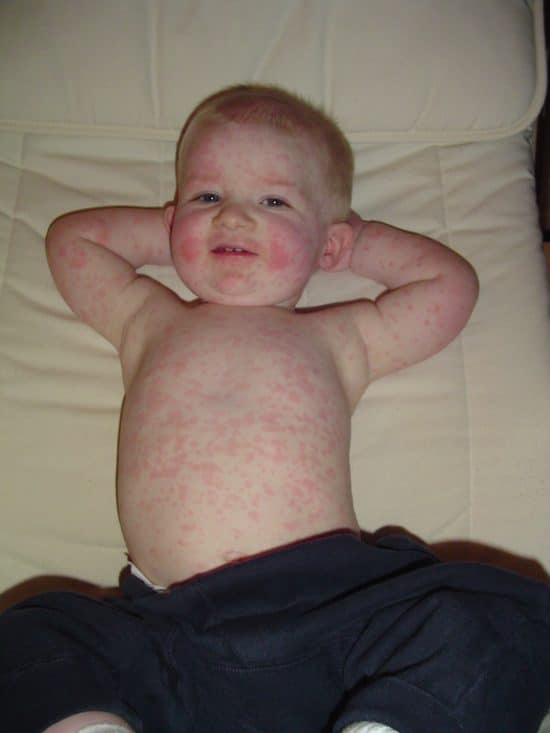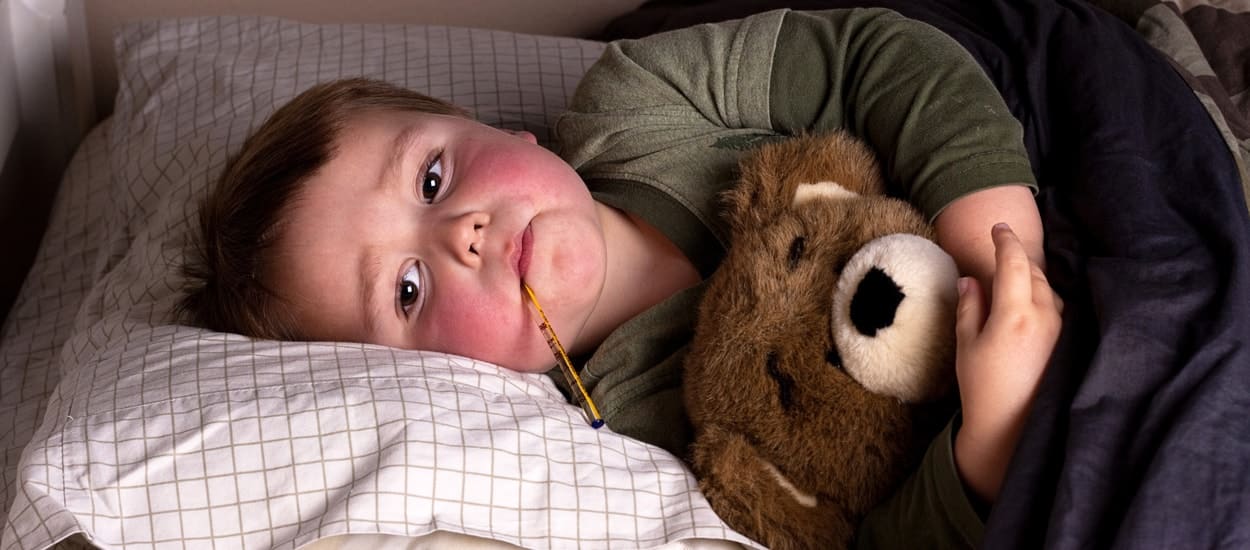Fifth disease. It’s the common name for a usually minor virus that mostly affects preschool and school-age children aged 5-15 years in the springtime. The medical name for fifth disease is erythema infectiosum and it is caused by parvovirus B19.
Fifth disease passes quickly and most children get better without complications. A parent might think the child coming down with fifth disease has a cold virus. At the start, there’s low fever, a headache and a stuffy or runny nose. Then the symptoms leave and the child seems to be all better.
A few days later, the rash comes out. The rash is bright red and starts with the face, eventually traveling down to the chest and back, buttocks, arms, legs, and bottoms of the feet. At first the child will look like someone slapped his face. In fact, doctors call it the “slapped cheek rash.” As the rash spreads downward, it looks more like red blotches.

Fifth Disease: A Lacy Pink Net
After a few days, the rash changes and begins to look like a lacy pink net, covering the skin. Sometimes the rash itches. It can take from 1-3 weeks for the rash to go away.
Fifth disease got its name by being the fifth childhood virus with a rash. The other viral rash diseases of childhood are measles, rubella, chicken pox, and roseola.
Not every child with fifth disease gets the rash. The rash is more common in kids below the age of 10 years. In 78% of older teens and adults, fifth disease can come with swollen, painful joints. The swelling and pain may last weeks or months. In rare cases, chronic joint pain and swelling can last for as many as 9 years.
Some adults with fifth disease only have painful joints and no other symptoms. This is called polyarthropathy syndrome. The affected joints are usually in the hands, feet, and knees. More women develop polyarthropathy syndrome than men. Most of the time (in 90% of cases), the pain lasts 1-3 weeks and goes away without any long-term issues.
It’s less common, but sometimes fifth disease comes with sore throat, reddened eyes, swollen glands, and diarrhea. Sometimes the rash is different and looks more like bruises or blisters. In other cases, some 20% of the time, a person with fifth disease will have no symptoms at all. Even without symptoms, the infection can spread to others.
Because of the way the rash spreads, a parent may think the child is getting worse. As the rash spreads and becomes lacy, however, it’s getting ready to fade away for good. Here’s the ironic thing about fifth disease: when you see the rash, the illness is usually no longer contagious.
The rash is the body’s way of reacting to the infection. This immune system reaction to parvovirus B19 happens only after the infection has cleared out of the system. Fifth disease is contagious during the early days of mild fever and cold symptoms, and usually not when the telltale bright red rash appears. In other words, fifth disease is only contagious when you don’t yet know what it is!
Fifth disease is difficult to prevent. There’s no vaccination for fifth disease. It’s hard not to spread the disease, since it seems like just a mild cold during the time fifth disease is contagious. The best thing to do is to wash your hands a lot whenever you or anyone you care for has cold symptoms.
It takes 4-14 days to develop fifth disease after being exposed to the virus. Parvovirus B19 is usually spread through the saliva, phlegm, or nasal mucus of an infected person who coughs or sneezes. The virus can also be spread through the blood, which is why a pregnant woman can pass fifth disease to her baby.
The doctor usually knows your child has fifth disease by looking at the rash. In the case where there is no rash, the doctor may need to do blood tests to find out if your child has fifth disease. A blood test can identify antibodies to parvovirus B19 only during the first two months after becoming infected. After that, a blood test can determine only whether someone had the virus at some point in the past.
Rest up!
As for treatment, well, it’s a virus. You can’t cure a virus with antibiotics. Antibiotics kill bacteria germs but do nothing for viruses. Fifth disease is mostly about resting up until it passes. The rash may be a bit uncomfortable. Talk to the doctor. Sometimes antihistamines may be prescribed for the itch. For joint pain, acetaminophen can be helpful. Just DO NOT give aspirin to your child, since aspirin use in children has been linked to Reye syndrome, a serious illness.
If your child isn’t uncomfortable from the rash of fifth disease, there’s no reason for him not to go to school. He isn’t contagious once the rash comes out. The teacher may want to see a doctor’s note confirming that the child is not contagious.
It’s important to note that while fifth disease is usually no big deal in healthy children, it can be a much bigger hazard for a child with a weakened immune system from leukemia or other cancer, an organ transplant, or HIV infection. The parvovirus B19 can slow or even stop the body from producing red blood cells. When this happens, there’s a danger of serious, chronic anemia. This complication may require treatment in the hospital. A person with a weakened immune system may also remain contagious with fifth disease for a longer period of time.
A pregnant woman who gets fifth disease is also in a special category. The developing fetus can be endangered by the mother’s infection with parvovirus B19. This is especially true during the early months of pregnancy. If you are pregnant and your child has fifth disease, it’s a good idea to consult your physician. A blood test may show you’ve already had fifth disease. If not, you should be monitored with extra care.
There isn’t much to do about fifth disease except to let it pass. But if your child develops a rash, or joint pain, it’s a good idea to speak to your doctor. Otherwise, make sure your child gets plenty of rest, drinks lots of fluids, and eats a healthy diet.
It’s no fun getting sick or having a rash. The good news is that once your child has had fifth disease, he’ll most likely have lifelong immunity and won’t ever get it again.
